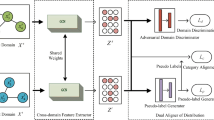Abstract
This paper proposes an unsupervised multi-source domain adaptation algorithm with graph convolution network and multi-alignment in mixed latent space, which leverages domain labels, data structure, and category labels in a unified network but improves domain-invariant semantic representation by several innovations. Specifically, a novel data structure alignment is proposed to exploit the inherent properties of different domains while using current domain alignment and classification result alignment. Through this design, category consistency can be considered in both latent space, and domain and structure discrepancy between different source domains and the target domain can be eliminated. Moreover, we also use category alignment based on both CNN and GCN features to optimize category decision boundary. Experiment results show that the proposed method brings sufficient improvement especially for adaptation tasks with large shift in data distribution.







Similar content being viewed by others
References
Noori, S., Tahmoresnezhad, J.: Joint distinct subspace learning and unsupervised transfer classification for visual domain adaptation. Signal Image Video Process. 15(2), 279–287 (2021)
Xu, R., Chen, Z., Zuo, W., et al.: Deep cocktail network: multi-source unsupervised domain adaptation with category shift. In: Proceedings of the IEEE Conference on Computer Vision and Pattern Recognition, pp. 3964–3973 (2018)
Zhu, Y., Zhuang, F., Wang, D.: Aligning domain-specific distribution and classifier for cross-domain classification from multiple sources. In: Proceedings of the AAAI Conference on Artificial Intelligence, pp. 5989–5996 (2019)
Zhao, S., Li, B., Xu, P., et al.: MADAN: multi-source adversarial domain aggregation network for domain adaptation. Int. J. Comput. Vis. 129, 2399–2424 (2021)
Ma, X., Zhang, T., Xu, C.: GCAN: graph convolutional adversarial network for unsupervised domain adaptation. In: Proceedings of the IEEE/CVF Conference on Computer Vision and Pattern Recognition, pp. 8266–8276 (2019)
Peng, X., Bai, Q., Xia, X., et al.: Moment matching for multi-source domain adaptation. In: Proceedings of the IEEE/CVF Conference on Computer Vision and Pattern Recognition, pp. 1406–1415 (2019)
Li, K., Lu, J., Zuo, H., et al.: Multi-source contribution learning for domain adaptation. IEEE Trans. Neural Netw. Learn. Syst. 99, 1–15 (2021)
Tzeng, E., Hoffman, J., Zhang, N., et al.: Deep domain confusion: maximizing for domain invariance. arXiv preprint arXiv:1412.3474 (2014)
Long, M., Cao, Y., Wang, J., et al.: Learning transferable features with deep adaptation networks. In: International Conference on Machine Learning, pp. 97–105 (2015)
Saenko, K., Kulis, B., Fritz, M., et al.: Adapting visual category models to new domains. In: Proceedings of European Conference on Computer Vision, pp. 213–226 (2010)
Venkateswara, Eusebio, H., Chakraborty, J., S., et al.: Deep hashing network for unsupervised domain adaptation. In: Proceedings of the IEEE Conference on Computer Vision and Pattern Recognition, pp. 5018–5027 (2017)
Venkat, N., Kundu, J. N., Singh, D., et al.: Your classifier can secretly suffice multi-source domain adaptation. arXiv preprint arXiv:2103.11169 (2021)
Li, K., Lu, J., Zuo, H., et al.: Multi-source domain adaptation with distribution fusion and relationship extraction. In: International Joint Conference on Neural Networks, pp. 1–6 (2020)
Zhao, H., Zhang, S., Wu, G., et al.: Adversarial multiple source domain adaptation. In: Proceedings of International Conference on Neural Information Processing, pp. 8559–8570 (2018)
Li, Y., Carlson, D., E.: Extracting relationships by multi-domain matching. In: Proceedings of International Conference on Neural Information Processing, pp. 6799–6810 (2018)
Wen, J., Greiner, R., Schuurmans, D.: Domain aggregation networks for multi-source domain adaptation. In: International Conference on Machine Learning, pp. 10214–10224 (2020)
Scalbert, M., Vakalopoulou, M., Couzini-Devy, F., et al.: Multi-source domain adaptation via supervised contrastive learning and confident consistency regularization. arXiv preprint arXiv:2106.16093 (2021)
He, K., Zhang, X., Ren, S., et al.: Deep residual learning for image recognition. In: Proceedings of the IEEE Conference on Computer Vision and Pattern Recognition, pp. 770–778 (2016)
Sun, B., Saenko, K.: Deep coral: correlation alignment for deep domain adaptation. In: Proceedings of European Conference on Computer Vision, pp. 443–450 (2016)
Ganin, Y., Lempitsky, V.: Unsupervised domain adaptation by backpropagation. In: Proceedings of International Conference on Machine Learning, pp. 1180–1189 (2015)
Long, M., Zhu, H., Wang, J., et al.: Unsupervised domain adaptation with residual transfer networks. arXiv preprint arXiv:1602.04433 (2016)
Na, J., Jung, H., Chang, H. J., et al.: FixBi: bridging domain spaces for unsupervised domain adaptation. In: Proceedings of the IEEE/CVF Conference on Computer Vision and Pattern Recognition, pp. 1094–1103 (2021)
Van der Maaten, L., Hinton, G.: Visualizing data using t-SNE. J. Mach. Learn. Res. 9(2605), 2579–2605 (2008)
Author information
Authors and Affiliations
Corresponding author
Additional information
Publisher's Note
Springer Nature remains neutral with regard to jurisdictional claims in published maps and institutional affiliations.
This work was supported by the National Nature Science Foundation of China under Grant 61872143.
Rights and permissions
Springer Nature or its licensor holds exclusive rights to this article under a publishing agreement with the author(s) or other rightsholder(s); author self-archiving of the accepted manuscript version of this article is solely governed by the terms of such publishing agreement and applicable law.
About this article
Cite this article
Chen, D., Zhu, H., Yang, S. et al. Unsupervised multi-source domain adaptation with graph convolution network and multi-alignment in mixed latent space. SIViP 17, 855–863 (2023). https://doi.org/10.1007/s11760-022-02298-w
Received:
Revised:
Accepted:
Published:
Issue Date:
DOI: https://doi.org/10.1007/s11760-022-02298-w




